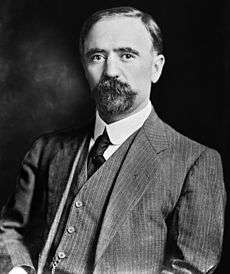Plan of San Luis Potosí

| A graphical timeline is available at Timeline of the Mexican Revolution |

The Plan of San Luis de Potosí (Plan de San Luis, in Spanish) was a political document written by presidential candidate Francisco I. Madero, who was jailed prior to the elections, and escaped to write the Plan. It was published on October 5, 1910. It called for nullifying the 1910 election of Porfirio Díaz, claimed a provisional presidency for Madero, and called for Mexicans to rise up on November 20, 1910.[1]
Background events
Liberal general and politician Porfirio Díaz had come to the presidency of Mexico in 1876 by coup against Sebastián Lerdo de Tejada. With a short interregnum in 1880-84, Díaz returned to power and remained there continuously until 1911. He gave an interview to a journalist working for a U.S. publication, James Creelman, saying that he would not run for another term in the 1910 presidential elections. This set off a flurry of political activity, including the entry into politics of a wealthy landowner from the state of Coahuila, Francisco I. Madero. Madero penned a work titled The Presidential Succession of 1910 and gathered support in Mexico for his candidacy, creating the Anti-Re-electionist Party. Díaz changed his mind about retiring from politics and ran for re-election. To assure his victory, had Madero jailed. Madero escaped and fled north, crossing the U.S. border at Laredo, Texas on 7 October 1910. The plan was drafted and reviewed in San Antonio, Texas, but "it was dated, for reasons of convenience, dignity, and neutrality, as in San Luis Potosí, the fifth of October, the last day Madero was in the city." He asked several Anti-Re-electionists, including Federico González Garza, Roque Estrada, Juan Sánchez Azcona, and Enrique Bordes Mangel, to review his rough draft, but it remained his work. It was "formulated to serve as the ideological banner of the revolution."[2] The plan was published in November 1910 and secretly distributed. It called for the revolt to begin at 6 p.m. on 20 November 1910.[3]
Content
This document contained many reasons why Diaz should not be in power anymore: scandalous election winning, stripping away of land, degrading citizens, and the causing of bankruptcy. The document, or 'plan', called for the destruction of Díaz's authoritarian presidency and the re-institution of democracy through violent direct action on the part of the Mexican populace. The results of this document were the start of the Mexican revolution and the collapse of the Presidency of Porfirio Díaz.
The Plan called for the Mexican people to rise up in arms on Sunday, November 20, 1910, at 6:00 pm and revolt against Diaz and overthrow his government. The first action occurred two days earlier, when Aquiles Serdán was found to be part of Madero's revolution in the state of Puebla and was forced to an early fight in his home, helped by his family. Most of them died. After that, the Mexican Revolution broke out on November 20, 1910 against the political, commercial and social policies of the regime, taking "Sufragio Efectivo, No Reelección [Effective Suffrage – No Re-election!]" as a slogan. This slogan can still be found at the foot of many official and legal documents written in Mexico.
Aftermath
The rebels in parts of Mexico, particularly in Mexico's north and in the state of Morelos, close to Mexico City, put pressure on the Díaz government. Díaz resigned in May 1911 and went into exile in Paris. An interim government was installed and new elections held, with Madero winning. He held office until February 1913, when disorder in Mexico City, known as the Ten Tragic Days (la decena trágica) provided the opportunity for a military coup by the head of the federal army, Victoriano Huerta. Madero and his vice president resigned under pressure and were then murdered. Forces counter to the Huerta government rose up, with Venustiano Carranza, a politician and wealthy land owner, becoming the leader of the northern forces. He issued the Plan of Guadalupe.
See also
References
- ↑ Stuart F. Voss, "Plan of San Luis Potosí". Encyclopedia of Latin American History and Culture vol. 4, p. 421. New York: Charles Scribner's Sons 1996.
- ↑ Stanley R. Ross, Francisco I. Madero: Apostle of Democracy. New York: Columbia University Press 1955, 114.
- ↑ Alan Knight, The Mexican Revolution vol. 1. Lincoln: University of Nebraska Press 1986, p. 77.
External links
- Partial English translation of the preamble to the Plan
- http://staff.4j.lane.edu/~hamill/americas/ayala.htm
- https://library.brown.edu/create/modernlatinamerica/chapters/chapter-3-mexico/primary-documents-with-accompanying-discussion-questions/document-4-plan-de-san-luis-de-potosi-francisco-madero-1910/
- http://www.legalflip.com/ThisDayInTheLaw.aspx?id=332